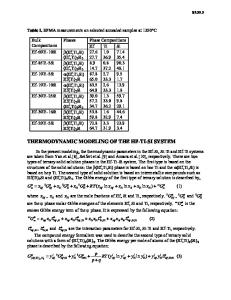Experimental study of phase equilibria and thermodynamic optimization of the Fe-Zn-O system
- PDF / 310,383 Bytes
- 15 Pages / 612 x 792 pts (letter) Page_size
- 67 Downloads / 356 Views
RODUCTION
THE study of the Fe-Zn-O system reported here is a part of a wider research program, which combines experimental measurements and thermodynamic modeling to characterize lead/zinc industrial slags and sinters. This program has resulted in the development of a self-consistent thermodynamic database which can be used with the F*A*C*T thermodynamic software package[1] to predict phase relations in the six-component system PbO-ZnO-CaO-FeO-Fe2O3-SiO2 and to calculate various slag properties, including activities and liquidus temperatures over a wide range of compositions and temperatures for lead/zinc industrial smelting processes. Some other subsystems studied within this overall research program have already been described in previous publications by the present authors.[2–8] In the thermodynamic “optimization” of a system, all available thermodynamic and phase-equilibrium data are evaluated simultaneously in order to obtain one set of model equations for the Gibbs energies of all phases as functions SERGEI A. DEGTEROV, Associate Research Professor, and ARTHUR D. PELTON, Professor, are with the Centre de Recherche en Calcul Thermochimique, E´cole Polytechnique de Montre´al, Montreal, PQ, Canada H3C 3A7. EVGUENI JAK, Senior Research Associate, and PETER C. HAYES, Associate Professor, are with the Department of Mining and Metallurgical Engineering, University of Queensland, Brisbane 4072, Queensland, Australia. Manuscript submitted January 13, 2000. METALLURGICAL AND MATERIALS TRANSACTIONS B
of temperature and composition. From these equations, all of the thermodynamic properties and the phase diagrams can be back-calculated. In this way, all the data are rendered self-consistent and consistent with thermodynamic principles. Thermodynamic property data, such as activity data, can aid in the evaluation of the phase diagram, and phasediagram measurements can be used to deduce thermodynamic properties. Discrepancies in the available data can often be resolved, and interpolations and extrapolations can be made in a thermodynamically correct manner. The present study started with an initial critical evaluation of all available reliable phase diagrams and thermodynamic data for the Fe-Zn-O system. The phase equilibria among hematite, spinel, zincite, and wustite solid solutions have been investigated extensively (the generic name “spinel” is used in this article for the solid solution between zinc ferrite and magnetite). However, significant discrepancies between experimental data were revealed, which resulted from experimental difficulties caused by high equilibrium zinc pressures at elevated temperatures. The high vaporization rates of zinc tend to change the sample composition during experiments. To resolve these problems, a new experimental investigation was carried out using an experimental technique which involves quenching of equilibrated samples followed by electron probe X-ray microanalysis (EPMA). This method eliminates the errors caused by changes in the sample bulk composition and makes it possible to cha
Data Loading...











